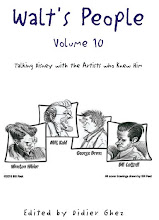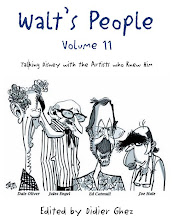The blog will be updated less often until September 14.
Thursday, August 27, 2015
I discovered this exceptional Japanese book last week and ordered it on Amazon.co.jp right away. I had never seen so many examples of artwork created by the Disney artists during WWII reproduced in a book. Combined with David Lesjak's Service With Character The Disney Studio and World War II (which contains the English explanations) this becomes a truly fabulous reference book and a "must have".
Friday, August 21, 2015
I received a copy of this book yesterday and was pleasantly surprised. It is much more interestingthan what I expected. The author cares about the subject matter and it shows. The book is not an in-depth history book, but it is not pure marketing "puff" either. There are dozens of wonderful surprises both within the text and among the illustrations. The layout is also a pure delight.
While this is not necessarily a "must have" for readers of this blog, it is a book that I am really happy to recommend snce it made me smile from ear to ear yesterday.
There is real care that went into the making of this book as well as the will to create something different instead of simply recycling known bits and pieces of information. This is refreshing and quite encouraging.
While this is not necessarily a "must have" for readers of this blog, it is a book that I am really happy to recommend snce it made me smile from ear to ear yesterday.
There is real care that went into the making of this book as well as the will to create something different instead of simply recycling known bits and pieces of information. This is refreshing and quite encouraging.
Thursday, August 20, 2015
Heads up from Are Myklebust about some great Disneyland-related documents that can be found at this link.
Tuesday, August 18, 2015
[Those Donald (and Daisy) Duck spoofs of Old Masters paintings recently discussed here bring to mind the two-minute animated sequence in the 2003 Warner Bros. feature film Looney Tunes: Back in Action, which can be viewed at this link.
The
sequence involves Elmer Fudd, shotgun in hand, madly pursuing Daffy
Duck and Bugs Bunny through the Louvre (Elmer must believe his
constitutional right to bear arms applies in France as well as the
U.S.). In the course of the chase the three characters enter into iconic
masterpieces by Salvador Dalí, Edvard Munch (The Scream), Toulouse-Lautrec, and Seurat, none of which are actually at the Louvre.
In the midst of the action we glimpse Whistler's momma, chair-bound, hopping across one of the galleries. Whistler's Mother once
was the only painting by an American in the world's most prestigious
museum (in 1975 the Louvre acquired a landscape by the founder of the
Hudson River School, Thomas Cole). In 1986, however, Whistler's Mother was transferred to the Musée d'Orsay, also in Paris, which showcases great mid- and late-19th-century art.
Some while back — in the 1970s or '80s, I think — an anonymous Disney artist created a pastiche of Whistler's famed composition with Minnie as the artist's mother (see below). Very much in the spirit of those Duck parodies from the late '30s ... though one can't help but wonder who "Minnie" was the mother of, and who it was that put her in a family way.
Whatever the answers to those portentous questions, one thing is certain. Mickey and Minnie's affection for Whistler's Mother goes way back — at least as far back as the May 1933 issue of the Mickey Mouse Magazine (also
copied below), published one year before the painting was further
immortalized on a U.S. commemorative postage stamp, on May 2, 1934.]
Friday, August 14, 2015
I am working on an in-depth essay about the making of The Reluctant Dragon, which will be released towards the end of next year in an upcoming book.
One small discovery which will not be part of the essay is that fact that it was Ward Kimball who drew the cover of the Reluctant Dragon book that Benchley carries around all through the movie.
One small discovery which will not be part of the essay is that fact that it was Ward Kimball who drew the cover of the Reluctant Dragon book that Benchley carries around all through the movie.
Wednesday, August 12, 2015
This just in from Are Myklebust:
[George Wheeler (also refered to as George D. Wheeler) was the artist behind the daily panel comic strip “True-Life Adventures”, which run in American newspapers from 1955 to 1973. It was written by Dick Huemer, a well known Disney animator and writer. Both worked on the “strip” during its complete run.
However very little is known about George Wheeler.
Could you please check out with your readers if anyone knows anything more about him, than the little information you can find about him here.]
[George Wheeler (also refered to as George D. Wheeler) was the artist behind the daily panel comic strip “True-Life Adventures”, which run in American newspapers from 1955 to 1973. It was written by Dick Huemer, a well known Disney animator and writer. Both worked on the “strip” during its complete run.
However very little is known about George Wheeler.
Could you please check out with your readers if anyone knows anything more about him, than the little information you can find about him here.]
Tuesday, August 11, 2015
This just in from Dave Mason:
[Were you already aware of this book? George Keller's connection to Disneyland was brief but memorable.]
I was not aware of this book and just ordered it.
[Were you already aware of this book? George Keller's connection to Disneyland was brief but memorable.]
I was not aware of this book and just ordered it.
Monday, August 10, 2015
This just in from Garry Apgar:
[Regarding your August 5th post of that
two-page spread of Old Masters pastiches
featuring Donald Duck, “Speaking of Pictures,” which, by the way, appeared in
the April 16, 1945 issue of Life
magazine . . .
Los Angeles Times film critic Philip K.
Scheuer, writing in the Times (April
2, 1939), said that Disney animators John Dunn, Phil Klein, and Ray Patin “started
the thing as a gag during a ‘lull in our work.’” In the May 1945 issue of The Animator (published by the then New-York
based Screen Cartoonists Guild), Dunn, Patin, and Klein were named as the
“perpetrators and artists” of the project.
In an
article titled “The
Disney Gallery of Old Masters: Off-Hour Creations of a Famous Studio,” in the Chicago Tribune (June 10, 1945),
Florabel Muir said that “It all started on a summer day back in 1938 when the boys
may have been a bit fed up with the toll of daily chores.” Muir added that this
“Disney art gallery of impish burlesques” began with a spoof of Gainsborough’s Blue Boy by Patin. She, too, named Dunn, Klein, and Patin as “the
boys” who created the gallery, while crediting an “animator artist
unidentified” with one work in the series, a parody of Rubens’s Portrait of a Lady.
Incidentally,
these pictures were drawings, not paintings, as carelessly stated in the brief
text that accompanied the images published in Life. The Animator said that
they “were done in colored pencils to simulate oils and pastels." Muir reported that
Patin used “a boxful of colored crayons made soft and pliable from a mixture of
graphite — the medium in which all Disney animators work.”
There
seems to have been thought, early on, of publishing the pastiches in book form.
In his book The Disney That Never Was
(1995), Charles Solomon described a conference on November 2, 1939 to discuss a
planned-but-never-made cartoon short about Donald Duck as a guard in an art museum.
During that meeting Walt Disney said:
“If we
could get them reproduced in Life,
it would do more good than putting them in a book. You get to three or four
million people that way, then you put your book out afterward. And you
could make reproductions — Courvoisier makes good reproductions. I’d like to have a set myself for a den or something. A
lot of people would be crazy to get them. The ones that holler bloody murder,
we don’t give a damn about them. The controversy is swell publicity. The
public at large is going to get a big kick out of it.”
These pictures (the bulk of which are now in a private collection) were indeed published
in Life, six years later, albeit not
in color — but Courvoisier never marketed prints of the series.
Finally,
as Hans Perk pointed out on his ever-useful website A. Film L.A., it should be noted for the record that there were two
John Dunns who worked for Disney back in the day. Patin and Klein’s fellow “perpetrator” was John J. Dunn
(Dec. 7, 1910 – Oct. 5,
1992). According to Joe Campana, Dunn was born in Canada, and worked for the
Disney studio “as an animator and story sketch artist, from Dec. 13, 1937 till
Aug. 1, 1946.”]
Friday, August 07, 2015
I will catch this on TV, of course, but there is no doubt I will soon also pre-order the DVD on Amazon. Does it hurt to be a little bit nuts? No really :-)
Thursday, August 06, 2015
[Greetings everyone,
I'm in search of attraction vehicles and props from attraction rides at Disneyland.
I'm looking for a Peoplemover, a Dumbo, and a bobsled from Matterhorn Mountain. I'd also be interested in any other attraction vehicle if you're interested in selling. I can trade items or purchase items. I can also handle all logistics associated with the move of your attraction vehicle. The vehicle will be going to a loving home and you may visit the vehicle at any time in the future. All exchanges will be strictly confidential and private.
Serious inquires please.
Anyone interested in selling or trading may contact me at the following email address:
samgoodies8@gmail.com ]
Tuesday, August 04, 2015
Fascinating post by one of the associate producers of the upcoming American Experience documentary. Not to be missed.
Monday, August 03, 2015
Today is a happy day. Michael Barrier has just released a massive interview with Wilfred Jackson on his blog, complete with some spectacular photos. Enjoy!
Subscribe to:
Comments (Atom)







































